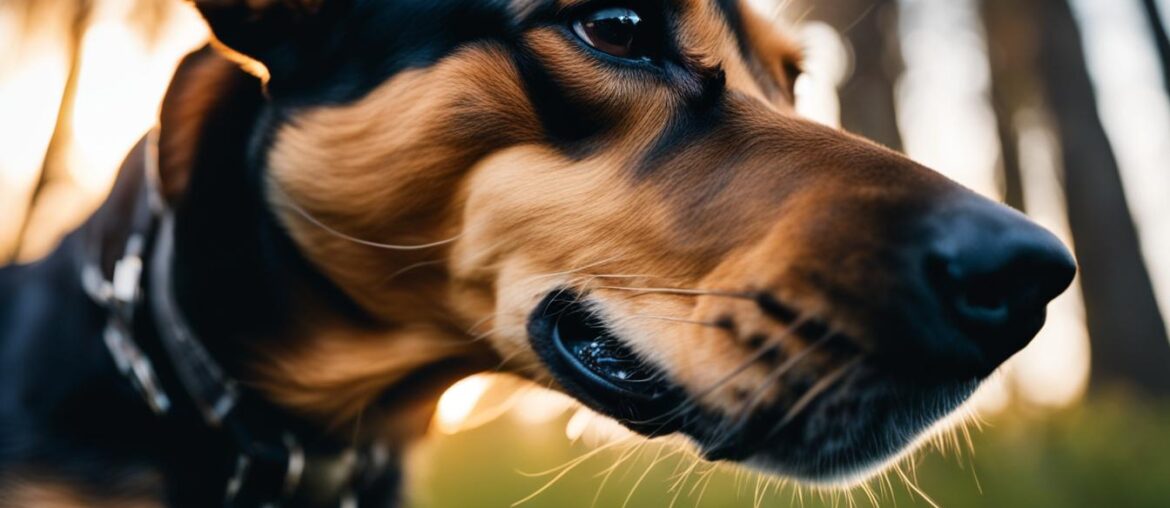When it comes to the incredible olfactory capabilities of dogs, their sense of smell is truly remarkable. Canine olfaction plays a crucial role in their communication and survival, allowing them to navigate the world and detect scents that are far beyond human comprehension. But just how far can a dog smell?
The range at which a dog can smell varies depending on various factors, including breed and weather conditions. On average, most dogs can differentiate scents within a 12-mile range, an astonishing distance that surpasses our human capabilities. But their scent tracking abilities don’t end there. In exceptional cases, dogs have been known to detect scents up to 40 miles underground.
While breed plays a significant role in determining a dog’s sense of smell, other factors also come into play. Wind speed and direction can greatly impact a dog’s olfactory efficacy. When the wind is blowing towards them, dogs can catch scents much faster as the wind carries odor molecules to their sensitive noses. On the other hand, if the wind is blowing away from them, it may take longer for them to detect the scent.
Humidity and rain can also affect a dog’s odor detection abilities. Increased humidity levels in the air allow for more scent molecules to be present, making it easier for dogs to pick up on odors. However, heavy rain can force scents to lower to the ground, making it more challenging for dogs to detect them.
Temperature also plays a role. High temperatures can cause dogs to switch from sniffing to panting, reducing their sniffing capabilities. Freezing temperatures, on the other hand, can lead to scent molecules becoming trapped in frozen air moisture.
A dog’s health can also impact their sense of smell. Certain health conditions, such as nasal tumors and infections, can cause breathing difficulties and impair their sense of smell.
So why do dogs have such an exceptional sense of smell? Dogs have a significantly higher number of smell receptors compared to humans, with an average of 125 to 250 million receptors compared to our mere 5 million. Additionally, dogs have a larger portion of their brain dedicated to processing scents, allowing them to accumulate and analyze scent molecules more effectively.
It’s fascinating to delve into the world of canine olfaction and explore the incredible abilities of dogs’ sense of smell. Their superior olfactory capabilities have been harnessed by humans for various purposes, including search and rescue missions, disease detection, and serving on the front lines of law enforcement.
Key Takeaways:
- Dogs can smell scents within a 12-mile range, and sometimes even up to 40 miles underground.
- Factors such as wind speed and direction, humidity, temperature, and a dog’s health can affect their scent detection abilities.
- Dogs have a significantly higher number of smell receptors and a larger portion of their brain dedicated to processing scents, which contributes to their exceptional sense of smell compared to humans.
- Health conditions such as nasal tumors and infections can impair a dog’s ability to detect scents.
- Breeds such as bloodhounds, German Shepherds, Beagles, and Labrador Retrievers are known for their excellent scent tracking abilities.
Wind Speed and Direction
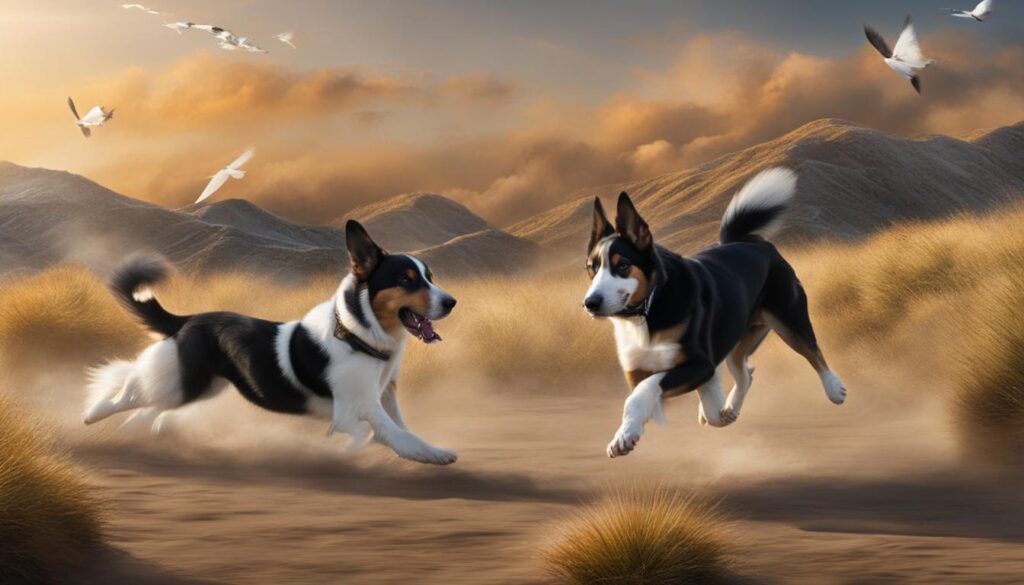
A dog’s sense of smell is greatly influenced by wind speed and direction. These factors play a crucial role in their ability to detect scents and engage in scent detection activities.
When the wind is blowing towards the dog, it becomes much easier for them to catch the scent. This is because the wind carries scent molecules towards the dog’s nose, increasing the chances of detection. In such conditions, dogs can quickly pick up on scents and track them effectively.
Conversely, when the wind is blowing away from the dog, it can take longer for them to detect the scent. This is because the wind carries scent molecules away from the dog’s nose, decreasing the chances of detection. In such situations, dogs may need to rely on other cues or wait for the scent to come closer to them.
Wind speed also affects a dog’s olfactory efficacy. A gentle breeze helps odor molecules spread out in the air, making it easier for the dog’s nose to capture them. This increased dispersion allows the dog to cover a wider area and detect scents more efficiently.
However, strong winds can have a negative impact on scent detection. The rapid movement of smells in strong winds can make it difficult for dogs to follow and pinpoint specific scents. The scattering of scent molecules can decrease the dog’s olfactory efficacy, making it challenging to track scents accurately.
Overall, wind speed and direction are important factors that influence a dog’s scent detection capabilities. By understanding how these factors affect the dog’s sense of smell, handlers and trainers can optimize scent-based tasks and create favorable conditions for the dog’s olfactory efficacy.
| Wind Speed | Wind Direction | Effect on Dog’s Sense of Smell |
|---|---|---|
| Gentle Breeze | Towards the Dog | The dog can detect scents more effectively as odor molecules are dispersed in the air. |
| Gentle Breeze | Away from the Dog | The dog may take longer to detect scents as odor molecules are carried away. |
| Strong Winds | Towards or Away from the Dog | Smells move too quickly, reducing the dog’s olfactory efficacy and making it challenging to track scents. |
Humidity and Rain
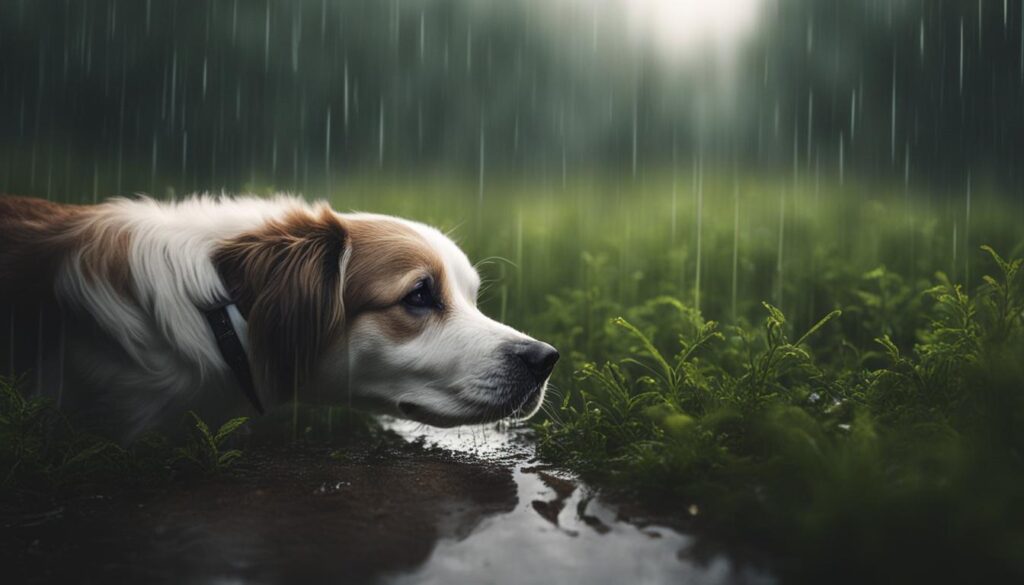
Humidity and rain can significantly impact a dog’s sense of smell and their ability to detect odors. The moisture in the air plays a crucial role in the distribution and detection of scent molecules, affecting the overall olfactory system of dogs.
Increased humidity levels create a favorable environment for scent molecules to linger in the air, making it easier for dogs to detect and follow odors. The abundance of scent molecules enhances a dog’s odor detection abilities, allowing them to pick up on scents more efficiently.
Light rain can also contribute to better humidity levels, aiding in odor detection. The gentle rain moistens the air, creating an optimal atmosphere for scent molecules to travel and be detected by a dog’s sensitive nose.
However, heavy rain can pose challenges for dogs in detecting scents. The raindrops force scent molecules to lower down to the ground, making it more difficult for dogs to detect them in the air. This change in the distribution of scents hampers the accuracy and range of a dog’s odor detection abilities.
Foggy weather conditions present another obstacle to a dog’s olfactory system. The presence of fog causes scents to linger excessively in the air, creating a heavy concentration of odor particles. This prolonged presence of scents can confuse or overwhelm a dog’s sense of smell, hindering their ability to accurately detect and differentiate between different odors.
In conclusion, humidity and rain play significant roles in a dog’s odor detection capabilities. While increased humidity levels and light rain can enhance a dog’s ability to detect scents, heavy rain and foggy weather can pose challenges. Understanding how weather conditions affect a dog’s sense of smell is important for optimizing their performance in various scent-related tasks and activities.
Temperature
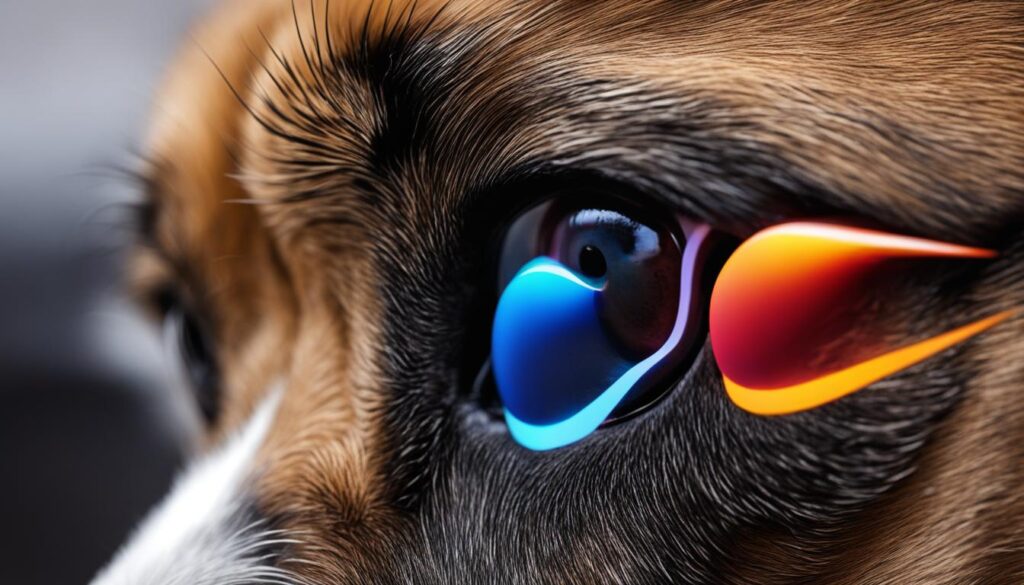
Temperature plays an essential role in a dog’s olfactory abilities. Fluctuations in temperature can impact their sense of smell, affecting their ability to detect scent molecules effectively.
High temperatures can have a negative impact on a dog’s sniffing capabilities. When dogs are exposed to hot weather, they may switch from sniffing to panting, as a way to regulate their body temperature and prevent overheating. This change in breathing pattern can reduce their ability to catch and analyze scent molecules in the air.
Dehydration is another factor that can affect a dog’s sense of smell in hot temperatures. When dogs become dehydrated, their nose becomes dry, which makes it less efficient at trapping scent molecules. Adequate hydration is crucial for maintaining optimal olfactory abilities.
On the other hand, freezing temperatures can also pose challenges to a dog’s sense of smell. In extremely cold weather, scent molecules may become trapped or frozen in air moisture, making it harder for dogs to detect and follow scents effectively.
It’s important to consider the temperature and weather conditions when relying on a dog’s olfactory skills, especially in extreme weather conditions where their sense of smell may be compromised.
| Temperature | Effect on Dog’s Sense of Smell |
|---|---|
| High temperatures | Switching from sniffing to panting, reduced sniffing capabilities, dehydration leading to a dry nose. |
| Freezing temperatures | Frozen scent molecules, reduced ability to detect and follow scents effectively. |
Health
A dog’s sense of smell can be significantly impacted by certain health conditions. Issues such as nasal tumors, injuries, and infections can cause improper airflow in the nasal passages, leading to breathing difficulties for the dog.
When the dog’s nasal passages are affected, it can affect their olfactory sense, making it harder for them to detect and interpret scents. The obstruction or blockage caused by nasal tumors or other conditions can interfere with the dog’s ability to properly inhale and process odor molecules.
In some cases, these health conditions can also result in a runny nose, further impairing the dog’s sense of smell. The excess mucus production can hinder the detection of scents by clogging the nasal passages and preventing the odor molecules from reaching the olfactory receptors.
It is essential for dog owners to monitor their pets’ health and seek veterinary care if they suspect any issues with their sense of smell. Early diagnosis and treatment of conditions affecting the nasal passages can help alleviate breathing difficulties and potentially restore the dog’s olfactory abilities.
Impact of Health Conditions on a Dog’s Sense of Smell
| Health Condition | Effect on Sense of Smell |
|---|---|
| Nasal Tumors | Obstruction of nasal passages, difficulty in inhaling odor molecules |
| Injuries | Damage to nasal passages, restricted airflow |
| Infections | Inflammation and congestion, hindrance in detecting scents |
Why Do Dogs Smell Better Than Humans?
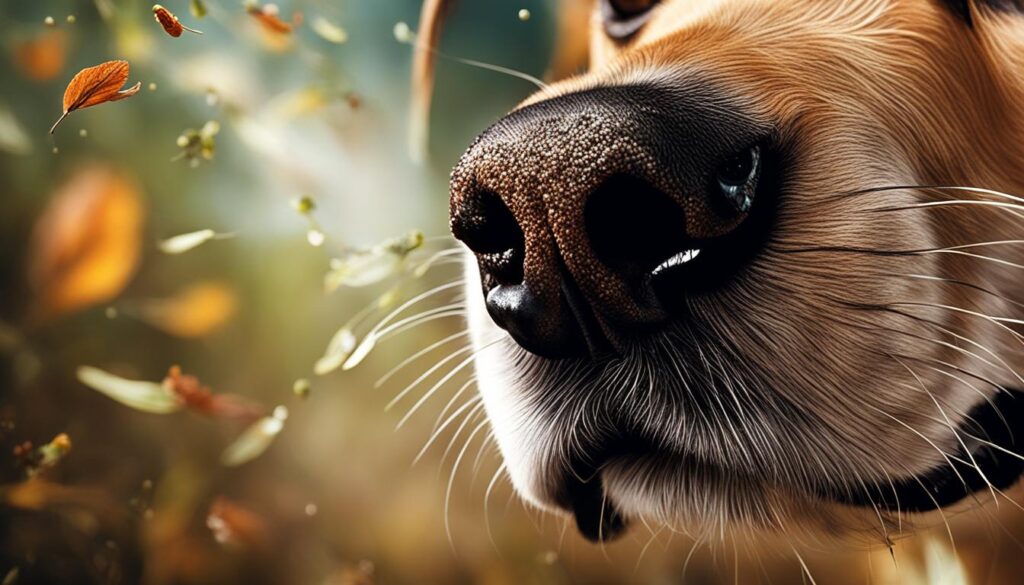
Dogs have a much stronger sense of smell compared to humans. They have a significantly higher number of smell receptors, with an average of 125 to 250 million receptors compared to the human average of 5 million. Dogs also have a larger portion of their brain dedicated to processing scents. Their ability to separate their breathing and smelling pathways allows them to accumulate and analyze scent molecules more effectively. Dogs also have a vomeronasal region in their mouths that processes organic scents like hormones for communication.
Why Dogs Have Such a Strong Sense of Smell

Dogs possess an incredible sense of smell that far surpasses that of humans. This heightened olfactory capability is due to a combination of factors that have evolved over time.
One of the primary reasons behind dogs’ exceptional sense of smell is their evolutionary history as hunters. Dogs’ ancestors relied on their olfactory capabilities to track and locate prey for survival. This innate hunting instinct has been passed down through generations, resulting in an exceptional sense of smell in modern-day dogs.
Beyond hunting, dogs utilize their sense of smell for various other purposes. They can effectively use their olfactory capabilities for communication. By detecting and interpreting the pheromones released by other dogs, they can gather valuable information about their reproductive status, health, and more.
In addition, dogs rely on their sense of smell to detect potential danger. They can pick up on subtle scents associated with threats, allowing them to alert their owners or take evasive action. This ability to sense danger is especially beneficial in search and rescue operations or as detection dogs for law enforcement agencies.
Dogs also possess a remarkable homing instinct, aided by their sense of smell. Even when taken to unfamiliar locations, dogs can rely on their olfactory capabilities to find their way back home. This navigational skill is a testament to the power and accuracy of their sense of smell.
Furthermore, dogs use their sense of smell to understand and interpret the world around them. Through scent, they can identify individuals, detect emotions, and even gauge the friendliness of people they encounter. This heightened olfactory sense provides dogs with valuable insights into their environment.
Overall, dogs’ strong sense of smell is a result of their evolutionary background as hunters, their ability to use scent for communication, the detection of danger, their homing instincts, and their understanding of the world through olfaction. These olfactory capabilities make dogs invaluable companions and partners in various fields, highlighting the truly extraordinary nature of their sense of smell.
Beneficial Aspects of Dogs’ Sense of Smell:
- Hunting and tracking abilities
- Communication through pheromone detection
- Detection of potential danger
- Homing instincts
- Understanding the world through scent
| Breed | Use Case |
|---|---|
| Bloodhound | Tracking scents over long distances |
| German Shepherd | Search and rescue, law enforcement |
| Beagle | Drug detection |
| Belgian Malinois | Military and police work |
| Basset Hound | Tracking game |
| Fox Terrier | Vermin control |
| Dachshund | Tracking, hunting small game |
| Labrador Retriever | Guide dogs, search and rescue |
| Golden Retriever | Therapy dogs, search and rescue |
These breeds represent just a few examples of dogs with exceptional olfactory capabilities and are often utilized in various fields where their sense of smell is of paramount importance.
Dog Breeds with The Best Sense of Smell
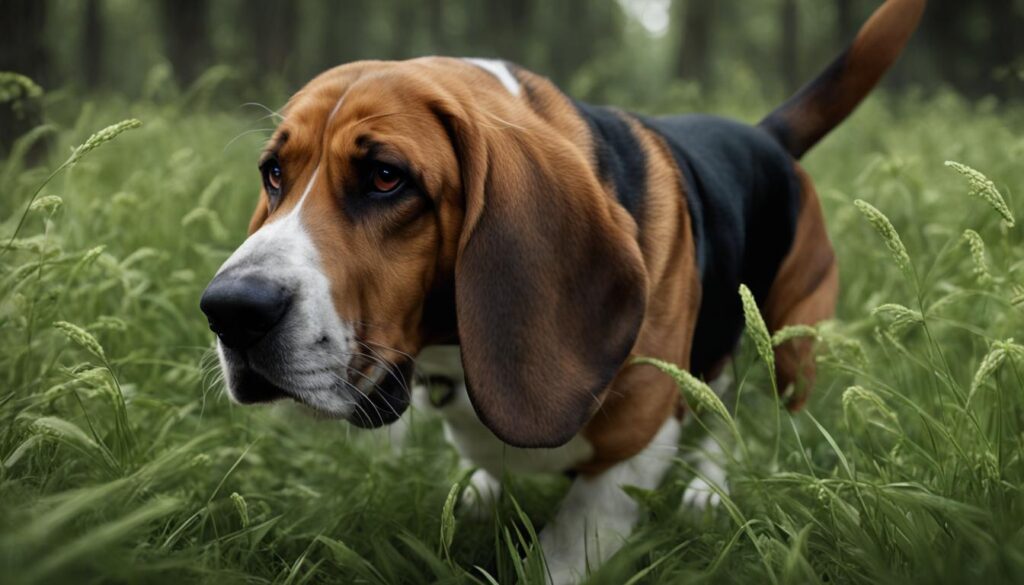
Some dog breeds possess an exceptional sense of smell. Among these breeds, the bloodhound stands out as having the strongest olfactory abilities. With an estimated 300 million smell receptors, the bloodhound’s nose is truly remarkable. This breed’s incredible scent tracking skills make them highly sought after for search and rescue operations, as well as detection tasks.
Other dog breeds renowned for their exceptional sense of smell include:
- German Shepherds: German Shepherds are known for their versatility and are frequently used in various scent-based tasks, such as drug detection and search and rescue operations.
- Beagles: Beagles are small but possess an incredible sense of smell. They are often employed as sniffer dogs at airports and border crossings.
- Belgian Malinois: Belgian Malinois are known for their intelligence and agility, making them excellent candidates for scent-based work, including explosive detection.
- Basset Hounds: Basset Hounds have long ears and a keen sense of smell, making them efficient at trailing scents on the ground. They are frequently used for tracking game.
- Fox Terriers: Fox Terriers are known for their sharp noses and were originally bred for hunting small game. Their strong sense of smell aids in tracking and hunting.
- Dachshunds: Dachshunds, with their elongated bodies and short legs, excel in tracking and flushing out prey. Their keen sense of smell assists them in these tasks.
- Labrador Retrievers: Labrador Retrievers are renowned for their friendly nature and their remarkable olfactory capabilities. They are commonly used in search and rescue missions and as assistance dogs.
- Golden Retrievers: Golden Retrievers possess an excellent sense of smell and are frequently used in search and rescue operations, as well as in therapy and assistance work.
These breeds are just a few examples of dogs with exceptional olfactory receptors. Their extraordinary sense of smell serves a variety of purposes, from working alongside humans in critical operations to enhancing our understanding of the world through their remarkable olfactory capabilities.
Dog Breeds with Enhanced Olfactory Capabilities
| Breed | Number of Smell Receptors (Estimated) | Main Applications |
|---|---|---|
| Bloodhound | 300 million | Search and rescue, tracking |
| German Shepherd | 225 million | Drug detection, search and rescue |
| Beagle | 220 million | Airport and border crossing sniffer dogs |
| Belgian Malinois | 225 million | Explosive detection, police work |
| Basset Hound | 220 million | Tracking game, trailing scents on the ground |
| Fox Terrier | 180 million | Hunting, tracking |
| Dachshund | 125 million | Tracking, flushing out prey |
| Labrador Retriever | 220 million | Search and rescue, assistance work |
| Golden Retriever | 225 million | Search and rescue, therapy, assistance work |
Wrapping Up
Throughout this article, we have explored the incredible sense of smell that dogs possess. Their olfactory abilities are truly remarkable, allowing them to detect scents over vast distances. The range at which a dog can smell is influenced by various factors such as breed, weather conditions, wind speed and direction, humidity, temperature, and the dog’s health.
Dogs’ sense of smell far surpasses that of humans, as they have a significantly larger number of smell receptors and a larger portion of their brain dedicated to processing scents. This exceptional olfactory capability of dogs has been harnessed by humans for various purposes, including search and rescue missions, disease detection, disaster rescues, and detecting drugs, bombs, and fires.
Dogs truly exemplify the power and sensitivity of the canine olfaction system. Their sense of smell is a remarkable tool that not only aids them in hunting and survival but also allows them to communicate, understand their environment, and navigate the world around them. The dog’s sense of smell is a testament to the fascinating capabilities of nature and serves as a reminder of the complex and diverse abilities of different species.
FAQ
How far can a dog smell?
Dogs can smell within a range of up to 12 miles, and they can even detect scents up to 40 miles underground.
How does wind speed and direction affect a dog’s sense of smell?
When the wind is blowing towards the dog, they can catch the scent much faster. However, if the wind is blowing away from the dog, it may take longer for them to detect the scent. Wind speed also plays a role, with gentle breezes aiding scent detection and strong winds hindering it.
How does humidity and rain impact a dog’s ability to smell?
Increased humidity allows for more scent molecules to be present, making it easier for dogs to detect odors. Light rain can also provide good humidity levels. However, heavy rain can make it more challenging for dogs to detect scents, and foggy weather can interfere with their olfaction.
Can temperature affect a dog’s sense of smell?
Yes, high temperatures can cause a dog to switch from sniffing to panting, reducing their sniffing capabilities. Freezing temperatures can also impact their olfactory abilities as scent molecules may become trapped in frozen air moisture.
How can a dog’s health impact their sense of smell?
Certain health conditions such as nasal tumors, injuries, and infections can cause breathing difficulties and negatively affect a dog’s sense of smell. Runny noses, often caused by these conditions, can further impair their ability to detect scents.
Why do dogs have a better sense of smell than humans?
Dogs have a significantly higher number of smell receptors and a larger portion of their brain dedicated to processing scents. They also have a vomeronasal region in their mouths that processes organic scents, giving them an advantage over humans.
Why do dogs have such a strong sense of smell?
Dogs have a strong sense of smell due to their evolutionary need to hunt for food. They also use their sense of smell for communication, detecting danger, having a homing instinct, and understanding their environment.
Which dog breeds have the best sense of smell?
Some dog breeds known for their excellent sense of smell include the bloodhound, German Shepherd, Beagle, Belgian Malinois, Basset Hound, Fox Terrier, Dachshund, Labrador Retriever, and Golden Retriever.
What are the overall olfactory abilities of dogs?
Dogs possess incredible olfactory capabilities, surpassing those of humans. They rely heavily on their sense of smell for communication and survival, with their olfactory system being used in tasks such as search and rescue, disease detection, and detecting drugs, bombs, and fires.


